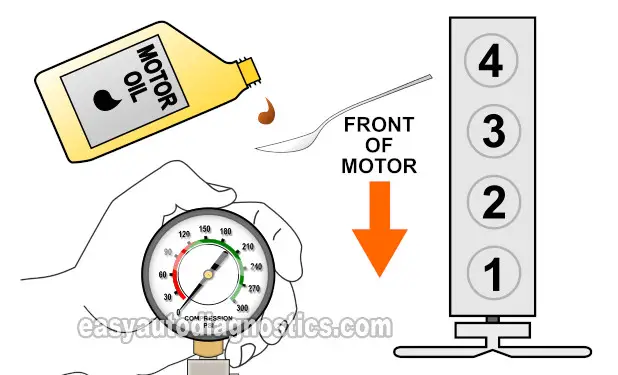How To Interpret The Engine Compression Test Results
Most likely, your compression test results will vary a little (or a lot). If they fluctuate more than 15%, you'll have a misfire or a rough idle problem on your hands.
It's not hard calculate the 15% difference. You can do it in one of two ways:
- Do the math with pen and paper.
- Use my low compression calculator.
If you want to use the low compression calculator, go here: Online Low Engine Compression Calculator.
If you want to manually calculate the 15% difference, here's what you'll need to do:
- STEP 1: Multiply the highest compression value by 0.15 (this is the decimal value of 15%).
- STEP 2: Round the result to the nearest one (for example: 25.6 would become 26).
- STEP 3: Subtract the result (the number that was rounded) from the highest compression value.
- ANSWER: The result of this subtraction is the lowest possible compression value any cylinder can have.
Now, let me give you a more specific example: Let's say that I got the following compression readings:
| Cylinder | Pressure |
|---|---|
| #1 | 165 PSI |
| #2 | 95 PSI |
| #3 | 155 PSI |
| #4 | 175 PSI |
My next step is to do the following calculation:
- STEP 1: 175 x 0.15 = 26.25.
- STEP 2: 26.25 = 26 (rounded to nearest one).
- STEP 3: 175 - 26 = 149.
- ANSWER: 149 PSI. Any cylinder with this compression (or lower) value will misfire.
Since cylinder #2 is only producing 95 PSI, I can now conclude that it's 'dead' and causing a misfire.
To find out if the lowest compression reading you got from your engine compression test is in a good range, you need to do the same calculation. Of course, you must use the highest compression value you got, not the one in the example.
Once you've found the 'dead' cylinder, the next step is to figure out what's causing the low compression reading. For this step, go to: TEST 2: Wet Engine Compression Test.
TEST 2: Wet Compression Test

In this section. you'll do a wet compression test on the cylinder(s) that gave a low compression reading.
The wet compression test is just a simple variation of the compression test you performed on the previous page. The difference is that you put about 2 tablespoons of engine oil in the low compression cylinder(s).
After adding the engine oil to the low compression cylinder, you'll test its compression again.
If the low compression is caused by worn piston rings, the oil will seal the rings (in the affected cylinder) and increase the compression pressure. This increase in pressure will be clearly visible on your compression tester.
If the problem is worn cylinder head valves, then no amount of oil will seal them and thus the compression reading will remain the same as the dry compression test your performed earlier.
OK, this is what you need to do:
- 1
Add a small amount of engine oil to the cylinder that reported low compression or no compression in the dry compression test
The amount should be about 1 to 2 tablespoons of oil. - 2
Install the compression tester onto the cylinder.
Do not use any type of tool to tighten the compression tester, hand tight is fine. - 3
When all is set up, have your helper crank the engine.
- 4
You'll get one of two results:
1.) The compression value will go up (from the one you recorded before).
2.) The compression value will stay the same.
Let's interpret your test results:
CASE 1: The compression value shot up. This tells you that the piston compression rings are worn and therefore the low compression problem is at the bottom.
CASE 2: The compression value remained the same. This confirms that the low compression problem is with the cylinder head valves.
More 2.3L Ford Ranger Diagnostic Tutorials
You can find a complete list of 2.3L Ford Ranger (Mazda B2300) tutorials in this index:
Here's a small sample of the tutorials you'll find in the index:
- How To Test The MAF Sensor (1995-1997 2.3L Ford Ranger).
- How To Test The Ignition Module And Crank Sensor (2.3L Ranger, Mustang, B2300).
- Testing The Blower Resistor (1995-1997 2.3L Ford Ranger) .
- How To Test For A Blown Head Gasket (1989-1997 2.3L Ford Ranger).

If this info saved the day, buy me a beer!


